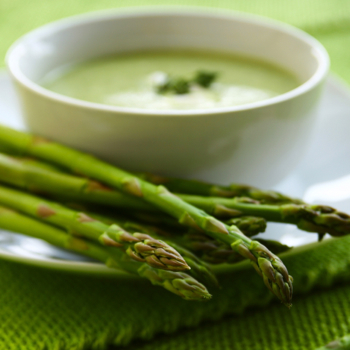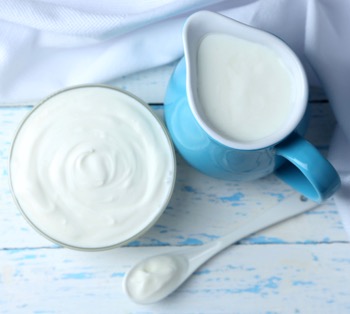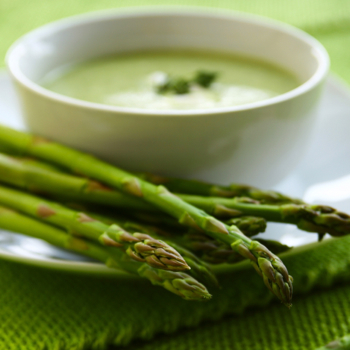Prebiotics are a relatively new discovery but emerging evidence is uncovering ample health benefits for these fermentable fibres. Read on to find out what we know about prebiotics right now.
What are Prebiotics?
Prebiotics are naturally occurring, non-digestible carbohydrates (fibre) that selectively promote the growth and activity of the good bacteria in our gut 1, 2. Although all prebiotics are fibre, not all fibre meets the criteria to be considered a prebiotic 3. In order for a type of fibre to be considered a prebiotic, it must meet the following three criteria:
- It has to make it to the large intestine undigested 2
- It must be fermented by bacteria in the large intestine 2
- It has to benefit certain types of helpful bacteria in the colon 2
Though this definition is still used by Health Canada, it is worth noting that prebiotics are a hotbed of active research and our knowledge is rapidly changing. A consensus panel of experts convened by the International Association for Probiotics and Prebiotics recently reviewed and updated the definition of prebiotics. The new definition no longer limits the term to non-digestible carbohydrates, but defines a prebiotic as “a substrate that is selectively utilized by host microorganisms conferring a health benefit”. This new definintion also recognizes that the benefit may be conferred to sites other than the intestine. The idea that there needs to be a benefit to health remains from the earlier defintiion 4.
What is the difference between pre- and probiotics?
According to Health Canada, probiotics are beneficial bacteria (live cultures) found in the gut that can have favorable effects on digestive health. Prebiotics promote the growth and/or activity of probiotics, helping these good bacteria survive in your digestive system and improve your gut health 5.
What are the different types of prebiotics?
The most commonly studied prebiotics are galactooligosaccharide (GOS), fructooligosaccharides (FOS), and resistant starches 3, 6, 7. Inulin is a type of FOS that is added to many foods 8, making it one of the more commonly consumed prebiotics.
Several other substances may fit the new definition for prebiotics, including polyphenols and some fatty acids. However, additional research is required to develop a convincing body of evidence that there is a health benefit 4.
Where are prebiotics found naturally?
Good news! Prebiotics, such as FOS, GOS, and resistant starches, are naturally found in a wide
variety of foods such as:

Vegetables and Fruit:
- Jerusalem Artichoke 1, 9
- Asparagus 10
- Bananas 9
- Garlic 9
- Leeks 9
- Onion 9
- Jicama (root vegetable) 11
Grains:
- Barley 11
- Oats 9
- Corn 9
- Wheat 9
Legumes:
- Soybeans 1, 9
- Lentils 6
- Red kidney beans 6
Dairy:
- Fermented dairy products like yogurt, buttermilk and kefir 10
- Heated milk (at least 65°C) 2, 12, 13
- Breast milk 9

Nuts
- Almonds and almond skins 14
Roots:
- Chicory root 9
- Dandelion root 14
Try to include some of these foods every day.
Foods that prebiotics may be added to:
- Breads and pastas 9
- Baked goods 9
- Yogurts 9
- Dressings and Sauces 15
- Snack bars 9
Many of these foods have the term ‘inulin’ or ‘chicory root’ in their ingredient list, indicating the presence of the prebiotic ingredient.
Other sources of prebiotics:
- Prebiotic supplements (e.g. Benefibre)
- Probiotic supplements (with added prebiotics)
- Fibre supplements (that contain inulin)
According to HealthlinkBC, if prebiotics are sold as supplements in Canada, they are regulated under the Natural and Non-prescription Health Products Directorate (NNHPD). If you choose to buy prebiotic supplements, look for products that have a Natural Product Number (NPN) or Homeopathic Medicine Number (DIN-HM) on the label. Remember that these numbers do not guarantee that prebiotics are effective, they just tell you that the supplement meets Health Canada’s standards for safety, quality, and health claims.
Do prebiotics have health benefits?
Studies have shown that prebiotics may play a role in reducing the incidence and duration of infectious diarrhea 2, 16; reducing the risk of developing colon cancer 9, 10, 16; enhancing anti-inflammatory effects 7, 9; improving resistance against the colonization of harmful bacteria 2, 9, 16; increasing mineral absorption in the large intestine (e.g. calcium) 2, 5, 9, 16; and they may help with weight loss 3, 16.
The health benefits associated with prebiotics looks promising. However, until more human studies come out proving their effectiveness, focusing on consuming foods high in prebiotics is a great place to start! The role of dietary fibre and health has been studied extensively, and has proven to have a positive impact on the prevention and treatment of many health conditions. Since most prebiotic foods are high in fibre, aiming to consume around 25 g of fibre/day for women and 38 g of fibre/day for men should help you achieve the health benefits that fibre has to offer. This is especially true if you are obtaining your fibre from multiple sources, as different types of fibre can benefit your body in different ways. If you aren’t sure how much fibre you are getting in a day, use FoodTrack—Check on Fibre to help you track your daily fibre intake.
How much prebiotic should I consume to see health benefits?
Currently, there is no specific recommended dose of prebiotics that people should take in a day to observe health benefits. The dose seems to be dependent upon the individual, the health condition that is being treated, and the type of prebiotic being consumed 7. With this being said, it has been suggested that around 5 grams of FOS or GOS may be needed to increase the amount of beneficial bacteria (probiotics) in the gut15. For other therapeutic purposes, the typical dose being tested is 5.5 to 20 g per day 15. Studies have shown that for most people, consuming around 10 g of prebiotics/day can offer therapeutic benefits while avoiding significant side effects 15, 17.

Diets that are less processed, and contain more plant-based foods can provide an average daily intake of 3-11 g of inulin-type prebiotics 18. Remember, inulin is just one type of prebiotic, so your total daily prebiotic intake would be higher if you factored in the prebiotics found in other food sources as well. Therefore, focusing on meeting the total daily fibre recommendations from a variety of foods, including foods that contain prebiotic fibres, should help you gain some of the benefits that prebiotics have to offer. If you choose to increase your prebiotic/fibre intake, start slowly and add extra fluid to help minimize any uncomfortable symptoms like gas and bloating that may arise with an increase in daily fibre.
Four ways to boost your prebiotic intake:
- cook your morning oatmeal with milk and top with almonds
- add dandelion greens to your salad at lunch
- add a chopped banana to your yogurt for an afternoon snack
- include lentils in your stew at supper
Bottom line:
Prebiotics are a relatively new discovery and evidence supporting their potential health benefits is only beginning to emerge. Currently, it appears that prebiotics can be included as part of a healthy diet. Although they are available as dietary supplements, prebiotic-containing foods may be all that you need to obtain their proposed health benefits. Plus, they happen to be naturally occurring in common, healthy foods!
By Carmen Gorlick, Dietetic Intern, with Sydney Massey, MPH, R.D.
updated February 2018

References
- https://naturalmedicines-therapeuticresearch-com.cyber.usask.ca/databases/food,-herbs-supplements/professional.aspx?productid=450. Accessed 30 Jan. 2017.
- Verspreet J et al. A critical look at prebiotics within the dietary fibre concept. Annu Rev Food Sci Technol. 2016;7:167-90. Accessed 30 Jan. 2017.
- http://inspection.gc.ca/food/labelling/food-labelling-for-industry/health-claims/eng/1392834838383/1392834887794?chap=10. Accessed 2 Feb. 2018.
- Gibson GR et al. Expert consensus document: The International Scientific Association for Probiotics and Prebiotics (ISAPP) consensus statement on the definition and scope of prebiotics. Nat Rev Gastroenterol Hepatol 2017; 14: 491–502.
- Pandey KR et al. Probiotics, prebiotics and synbiotics- A review. J Food Sci Technol. 2015; 52(12): 7577–7587. Accessed 30 Jan. 2017.
- Fuentes-Zaragoza E et al. Resistant starch as prebiotic: A review. Starch/Stärke. 2011; 63(7): 406–415. Accessed 30 Jan. 2017.
- http://cdhf.ca/en/videos/prebiotics-the-ultimate-fibre-. Accessed 30 Jan. 2017.
- https://naturalmedicines-therapeuticresearch-com.cyber.usask.ca/databases/food,-herbs-supplements/professional.aspx?productid=1048. Accessed 30 Jan. 2017.
- http://isappscience.org/prebiotics/. Accessed 30 Jan. 2017.
- https://naturalmedicines-therapeuticresearch-com.cyber.usask.ca/databases/food,-herbs-supplements/professional.aspx?productid=1462. Accessed 30 Jan. 2017.
- Chatterjee A et al. Probiotics in periodontal health and disease. J Indian Soc Periodontol. 2011; 15(1): 23–28. Accessed 30 Jan. 2017.
- Lan XY et al. Effects of Heating Temperatures and Addition of Reconstituted Milk on the Heat Indicators in Milk. Journal of Food Science. 2010; 75(8): 653–658. Accessed 30 Jan. 2017.
- Oliveira R et al. Use of lactulose as prebiotic and its influence on the growth, acidification profile and viable counts of different probiotics in fermented skim milk. International Journal of Food Microbiology. 2011;145:22–27. Accessed 30 Jan. 2017.
- Winston C. A gut feeling. Vibrant Life. 26(5):16. Accessed 30 Jan. 2017.
- Florowska A et al. Prebiotics as functional food ingredients preventing diet-related diseases. Food Funct. 2016;7(5):2147-2155.Accessed 30 Jan. 2017.
- Slavin J. Fiber and Prebiotics: Mechanisms and Health Benefits. Nutrients 2013; 5(4):1417-1435. Accessed 30 Jan. 2017.
- http://www.pennutrition.com.cyber.usask.ca/viewhandout.aspx?Portal=UbY=&id=JMzoXwM=&PreviewHandout=bA==. Accessed 30 Jan. 2017.
- http://www.tandfonline.com.cyber.usask.ca/doi/pdf/10.1080/20014091091841?needAccess=true Accessed 30 Jan. 2017.
